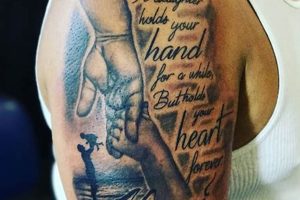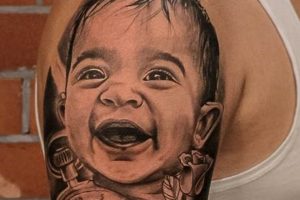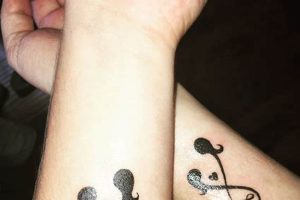Matching or coordinating ink designs serve as permanent expressions of familial bonds, particularly between a mother and her children. These designs can range from simple, shared symbols to more complex, personalized artwork reflecting shared experiences, inside jokes, or tributes to loved ones. For instance, birthdates rendered in Roman numerals, matching floral motifs, or a design incorporating each individual’s birthstone are popular choices.
Permanent body art offers a unique way to solidify and celebrate family connections. These visible reminders of shared heritage and enduring affection can offer comfort, strengthen bonds, and serve as a source of personal meaning. Historically, body art has symbolized kinship and belonging across various cultures. Contemporary family tattoos continue this tradition, allowing individuals to express their commitment to family in a modern and artistic way.
This article will explore various design concepts suitable for mothers, sons, and daughters seeking to commemorate their relationship through shared tattoos. Topics covered will include stylistic considerations, placement options, symbolic imagery, and practical advice for choosing a design that resonates with each family member.
Tips for Choosing Family Tattoos
Selecting meaningful and aesthetically pleasing designs requires careful consideration. The following tips offer guidance for families embarking on this shared experience.
Tip 1: Consider Shared Interests: Incorporate elements reflecting common passions, such as a favorite animal, a shared hobby (like music or travel), or a beloved literary quote.
Tip 2: Explore Symbolic Imagery: Research symbols representing family, love, strength, or protection. Celtic knots, infinity symbols, and tree designs are popular options.
Tip 3: Think About Placement: Choose a location suitable for each individual’s comfort level and lifestyle. Consider visibility preferences and potential workplace restrictions.
Tip 4: Consult with a Professional Tattoo Artist: Discuss design ideas with an experienced artist to refine concepts and ensure technical feasibility.
Tip 5: Factor in Individual Styles: While cohesive elements are important, allow room for personalized touches to reflect each person’s unique aesthetic.
Tip 6: Start Small: For first-time tattoos, beginning with smaller, simpler designs can be less daunting.
Tip 7: Discuss Aftercare Together: Ensure everyone understands proper aftercare procedures to promote healing and preserve the integrity of the tattoos.
By following these guidelines, families can create meaningful, lasting tributes to their bond.
The process of choosing and getting matching tattoos can be a powerful bonding experience. By thoughtfully considering these elements, families can ensure a positive and memorable outcome.
1. Symbolic Representation
Symbolic representation forms the core of meaningful family tattoos, allowing individuals to express complex emotions and shared experiences through carefully chosen imagery. The selection of appropriate symbols transforms simple body art into powerful, personal statements reflecting the unique bond between a mother, son, and daughter.
- Family Unity
Symbols representing interconnectedness, such as Celtic knots, infinity symbols, or intertwined trees, serve as visual metaphors for the enduring strength and unity of the family unit. A mother, son, and daughter might choose a three-strand Celtic knot to represent their individual identities woven together into a single, unbreakable bond. This emphasizes the enduring nature of familial ties.
- Shared Experiences/Interests
Incorporating imagery related to shared passions or memorable experiences adds a deeply personal touch to family tattoos. For instance, a family who enjoys hiking together might choose mountain imagery, or a family with a shared love of music might incorporate musical notes or instruments into their designs. These shared symbols commemorate specific moments or ongoing connections.
- Love and Protection
Symbols representing love, guidance, and protection, such as hearts, compasses, or guardian angel wings, can convey the enduring affection and care within the family. A mother might choose a design incorporating a heart and a compass, symbolizing her unwavering love and guidance for her children. This offers a powerful visual representation of maternal love.
- Personal Growth and Transformation
Butterflies, blossoming flowers, or unfurling leaves can symbolize growth, resilience, and the evolving nature of familial relationships. These symbols acknowledge individual journeys while celebrating the continuous support and connection within the family unit. For example, matching butterfly tattoos could represent the children’s journey into adulthood and the mother’s supportive role in their transformation. This captures the dynamic nature of family relationships.
By thoughtfully selecting symbolic elements, families can create tattoos that serve as enduring reminders of their shared history, mutual love, and ongoing connection. These carefully chosen symbols transform simple body art into powerful expressions of familial bonds.
2. Cohesive Style
Cohesive style plays a crucial role in unifying individual tattoo designs for a mother, son, and daughter, creating a visually harmonious representation of their shared bond. While personalized elements are important, maintaining a consistent aesthetic across all tattoos ensures a sense of connection and belonging. This involves careful consideration of various design elements, such as color palettes, linework, and overall artistic style.
- Consistent Color Palette
Utilizing a shared color palette creates an immediate visual link between the tattoos. This could involve incorporating the same dominant color in each design or limiting the palette to a specific range of hues. For example, a family might opt for a monochromatic theme using varying shades of blue, or incorporate each individual’s birthstone color into a shared floral design. This shared color scheme creates a sense of harmony and unity.
- Complementary Linework and Shading
Maintaining similar line weights and shading techniques across the tattoos further enhances visual cohesion. Whether choosing bold, traditional lines or delicate, fine lines, consistency in execution is key. This creates a sense of balance and interconnectedness, even if the individual designs differ significantly. For example, if one family member opts for a realistic portrait, the others might choose designs incorporating similar shading techniques to maintain a cohesive aesthetic.
- Unified Artistic Style
Selecting a shared artistic style, such as watercolor, geometric, or traditional, provides a strong unifying element. This ensures that the tattoos, despite individual variations, appear as a cohesive collection rather than disparate designs. For example, a family might choose a minimalist geometric style incorporating simple shapes and clean lines, or opt for a vibrant watercolor style with flowing colors and abstract forms. This shared style creates a sense of visual harmony.
- Adapting to Individual Preferences
While cohesion is important, individual preferences should also be considered. A skilled tattoo artist can adapt a chosen style to suit different design elements, ensuring each tattoo reflects individual personality while maintaining a cohesive overall aesthetic. For instance, a family might agree on a floral theme but choose different flowers representing individual preferences, rendered in a consistent artistic style. This balances unity with individual expression.
By carefully considering these elements, families can create a collection of tattoos that not only celebrate their individual identities but also emphasize their shared bond through a cohesive and harmonious visual narrative. This cohesive style reinforces the sense of connection and belonging, transforming individual tattoos into a powerful symbol of family unity.
3. Personalized Elements
Personalized elements are crucial for transforming generic tattoo designs into meaningful tributes reflecting the unique dynamics of a mother-son-daughter relationship. These individual touches add depth and significance, ensuring each tattoo resonates with the wearer’s personality and role within the family while contributing to a cohesive overall narrative.
- Birthdates and Names
Incorporating birthdates, rendered in Roman numerals or other stylized scripts, adds a personal touch and commemorates significant milestones. Names, initials, or nicknames can also be integrated, further personalizing the design and representing individual identities within the family unit. For example, a mother might tattoo her children’s birthdates on her wrist, while the children could incorporate her initials into their respective designs.
- Individual Symbols
Each family member can select symbols representing individual interests, hobbies, or personality traits. A son passionate about music might incorporate a treble clef, while a daughter who loves nature might choose a floral motif. These personalized symbols celebrate individuality within the shared family narrative. For example, if each child has a specific birth flower, those flowers could be incorporated into a shared design, representing both individuality and unity.
- Meaningful Quotes or Scriptures
Short, meaningful quotes, song lyrics, or religious scriptures can add a deeply personal layer to the tattoo design. These textual elements can represent shared values, inside jokes, or inspiring messages that resonate with each family member. A quote representing family unity or a shared favorite song lyric can serve as a powerful reminder of the bond between a mother, son, and daughter.
- Stylistic Variations
Even within a cohesive style, individual variations can be introduced through color choices, size, or specific design elements. For instance, a family might choose a shared symbol like a tree, but each individual could personalize it with different leaf colors, branch patterns, or added elements like birds or butterflies. This allows for individual expression while maintaining a cohesive theme.
By incorporating these personalized elements, families create tattoos that not only symbolize their shared bond but also celebrate their unique identities within that bond. These individual touches enhance the meaning and significance of the tattoos, transforming them into cherished personal narratives reflecting the complex and beautiful dynamics of a mother-son-daughter relationship.
4. Placement Considerations
Placement considerations are integral to tattoo design, especially for families seeking to express their bond through shared ink. Placement affects visibility, comfort, and the overall aesthetic of the tattoo. For mother-son-daughter tattoos, placement choices can further personalize the design and reflect the unique dynamics of each relationship. Factors influencing placement include pain tolerance, lifestyle, and professional considerations. For example, a mother might choose the inner wrist for a small, delicate design incorporating her children’s initials, a location both visible and easily concealed. A son might opt for a larger, more visible design on his forearm, while a daughter might prefer a discreet placement on her ankle or behind the ear. These choices reflect individual preferences while contributing to the overall family narrative.
The visibility of the tattoo also plays a significant role. A highly visible placement, like the forearm or hand, can serve as a constant reminder of the family connection and a public declaration of affection. A more discreet placement, such as the ribcage or back, offers a sense of intimacy and personal significance. Practical considerations also influence placement choices. Areas subject to frequent friction or sun exposure might require more diligent aftercare. For individuals in professions with dress codes, easily concealed placements are often preferred. Considering these factors ensures the chosen location complements the design and aligns with each individual’s lifestyle.
Ultimately, thoughtful placement enhances the meaning and impact of mother-son-daughter tattoos. It allows individuals to express their connection in a way that feels both personal and meaningful, considering practical aspects and individual preferences. By carefully evaluating these factors, families can ensure their chosen tattoos serve as beautiful and enduring symbols of their shared bond.
5. Artist Collaboration
Effective collaboration with a skilled tattoo artist is paramount when realizing meaningful and aesthetically cohesive tattoo designs for a mother, son, and daughter. A skilled artist serves as both a creative partner and a technical advisor, guiding the family through the design process, ensuring the final product meets their expectations and adheres to best practices. Open communication, clear articulation of design preferences, and a collaborative spirit are essential for a successful outcome.
- Conceptualization and Refinement
Initial design concepts often require refinement and adaptation to translate effectively into tattooable artwork. Artists provide valuable input on scale, composition, color palettes, and technical feasibility, transforming initial ideas into polished, cohesive designs suitable for each individuals chosen placement. They may suggest modifications to ensure the design’s longevity, clarity, and visual impact, balancing personal preferences with artistic principles.
- Technical Expertise and Execution
Artists possess the technical expertise to execute designs with precision and artistry. Their knowledge of skin types, needle sizes, ink properties, and proper aftercare procedures ensures a safe and successful tattooing experience. They can advise on appropriate line weights, shading techniques, and color saturation to achieve the desired aesthetic and ensure the longevity of the design. This expertise is crucial for translating complex designs into lasting works of art.
- Personalized Adaptation and Cohesion
Maintaining a cohesive aesthetic across multiple tattoos while accommodating individual preferences requires careful planning. Artists can adapt a chosen theme or style to suit individual tastes and placements, ensuring each tattoo complements the others while reflecting individual personalities. This involves carefully considering the relationship between individual elements and the overall composition, ensuring a unified visual narrative. For instance, they can adapt a chosen motif to different sizes or incorporate varying color palettes while maintaining a cohesive style.
- Communication and Understanding
Clear communication between the family and the artist is fundamental. Families should articulate their vision, preferences, and symbolic intentions clearly, while artists provide guidance on technical aspects and design considerations. This open dialogue ensures the final design reflects the familys shared vision and aligns with their expectations. Active listening and constructive feedback are essential throughout the process, fostering a strong collaborative relationship.
Through effective artist collaboration, families can transform their vision for shared tattoos into beautifully executed, meaningful expressions of their bond. The artist’s expertise and creative input enhance the design process, ensuring a cohesive and personalized outcome that resonates with each individual and celebrates their unique connection. This collaborative approach results in tattoos that serve as lasting reminders of family unity and shared experiences.
Frequently Asked Questions
This section addresses common inquiries regarding family tattoos, offering practical guidance and clarifying potential concerns.
Question 1: What are the most popular design choices for mother-son-daughter tattoos?
Popular choices include matching or coordinating symbols (e.g., hearts, infinity symbols, Celtic knots), floral motifs, birthdates in Roman numerals, and meaningful quotes or scriptures.
Question 2: How can individual preferences be incorporated while maintaining a cohesive design?
A skilled tattoo artist can adapt a shared theme or style to suit individual tastes. This might involve variations in color, size, or specific design elements within a larger, unified concept. For example, a shared floral motif could incorporate each individual’s birth flower.
Question 3: What factors should be considered when choosing a tattoo placement?
Placement depends on pain tolerance, desired visibility, lifestyle, and professional considerations. Easily concealed locations are often preferred for professional settings.
Question 4: How much do family tattoos typically cost?
Costs vary based on size, complexity, artist experience, and studio location. Consulting multiple artists for quotes is recommended.
Question 5: What is the best way to find a reputable tattoo artist?
Research local artists, review portfolios, and seek recommendations from trusted sources. Verify artist licensing and studio hygiene practices.
Question 6: What aftercare procedures are essential for family tattoos?
Proper aftercare is crucial for healing and preserving the tattoo’s integrity. Follow artist instructions diligently, which typically involve keeping the tattoo clean, moisturized, and protected from sun exposure.
Careful planning and open communication with a skilled artist are essential for creating meaningful, well-executed family tattoos. Consulting these frequently asked questions will provide additional clarity and guidance in the decision-making process.
For further inspiration and design ideas, explore the image gallery in the next section showcasing a diverse range of mother-son-daughter tattoo concepts.
Conclusion
Exploring permanent body art designs for mothers, sons, and daughters reveals the profound potential for expressing familial bonds through shared imagery. Careful consideration of symbolic representation, cohesive style, personalized elements, placement, and artist collaboration are crucial for achieving meaningful and aesthetically pleasing results. This exploration has highlighted the significance of shared interests, symbolic imagery, individual preferences, and practical considerations in creating tattoos that resonate with each family member.
Ultimately, these shared designs serve as enduring testaments to familial love and connection, transforming personal narratives into tangible works of art. The thoughtful selection of imagery and collaborative design process strengthens family bonds, creating lasting reminders of shared history and mutual affection. These permanent expressions of kinship offer a powerful way to celebrate and commemorate the unique and enduring bond between a mother, son, and daughter.







